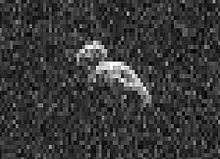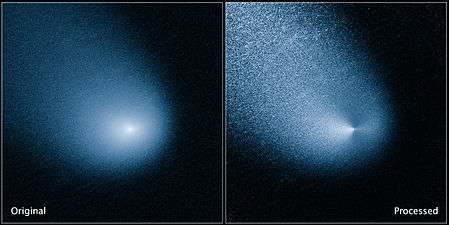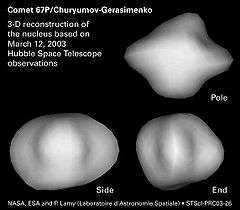2014 DX110
| Discovery[1] | |
|---|---|
| Discovered by | Pan-STARRS (F51) |
| Discovery date | 28 February 2014 |
| Designations | |
| MPC designation | 2014 DX110 |
| Apollo, NEO[2] | |
| Orbital characteristics[2] | |
| Epoch 13 January 2016 (JD 2457400.5) | |
| Uncertainty parameter 6 | |
| Aphelion | 3.5778 AU (535.23 Gm) (Q) |
| Perihelion | 0.82623 AU (123.602 Gm) (q) |
| 2.2020 AU (329.41 Gm) (a) | |
| Eccentricity | 0.62479 (e) |
| 3.27 yr (1193.5 d) | |
| 193.14° (M) | |
| 0° 18m 5.832s / day (n) | |
| Inclination | 5.7362° (i) |
| 163.83° (Ω) | |
| 56.517° (ω) | |
| Earth MOID | 0.00157599 AU (235,765 km) |
| Jupiter MOID | 1.4237 AU (212.98 Gm) |
| Physical characteristics | |
| Dimensions |
~23 meters (75 ft)[3] 20–40 m (66–131 ft)[4] |
| Mass | 1.6×107 kg (assumed)[3] |
| 0.12041 h (7.225 min) | |
| 15–32 | |
| 25.7[2] | |
|
| |
2014 DX110 (also written 2014 DX110) is an Apollo near-Earth asteroid roughly 20–40 m (66–131 ft) in diameter that passed less than 1 lunar distance from Earth on 5 March 2014.[5] With an absolute magnitude (H) of 25.7,[2] 2014 DX110 is potentially the largest asteroid to come inside the orbit of the Moon since 2013 PJ10 on 4 August 2013. The close approach was webcast live by Slooh and Virtual Telescope.[6][7]
The asteroid came to opposition (furthest elongation in the sky from the Sun) on 15 February 2014, but the asteroid had a very faint apparent magnitude of about 23 and was only 10 degrees from the full moon.[8] The asteroid was discovered on 28 February 2014 by Pan-STARRS at an apparent magnitude of 20 using a 1.8-meter (71 in) Ritchey–Chrétien telescope.[1]
On 5 March 2014 at 21:00 UT the asteroid passed 0.00232 AU (347,000 km; 216,000 mi) from Earth[5] and reached about apparent magnitude 15.[8][9] At 22:22 UT it passed 0.00249 AU (372,000 km; 231,000 mi) from the Moon.[5] By 6 March 2014 18:00 UT, the asteroid was less than 30 degrees from the Sun and dimming significantly.[8]
It has an observation arc of 5 days with an uncertainty parameter of 6.[2] It was removed from the JPL Sentry Risk Table on 5 March 2014 using JPL solution 3 with an observation arc of 5 days.[10] When the asteroid only had an observation arc of 4 days, virtual clones of the asteroid that fit the uncertainty region in the known trajectory showed a 1 in 10 million chance that the asteroid could impact Earth on 4 March 2046.[3] With a 2046 Palermo Technical Scale of −7.11,[3] the odds of impact by 2014 DX110 in 2046 were about 13 million times less[11] than the background hazard level of Earth impacts which is defined as the average risk posed by objects of the same size or larger over the years until the date of the potential impact.[12] Using the nominal orbit, NEODyS shows that the asteroid will be 2.8 AU (420,000,000 km; 260,000,000 mi) from Earth on 4 March 2046.[13]

References
- 1 2 "MPEC 2014-E22 : 2014 DX110". IAU Minor Planet Center. 2 March 2014. Retrieved 4 March 2014. (K14DB0X)
- 1 2 3 4 5 "JPL Small-Body Database Browser: (2014 DX110)" (last observation: 5 March 2014; arc: 5 days). Jet Propulsion Laboratory. Retrieved 4 April 2016.
- 1 2 3 4 "Earth Impact Risk Summary: 2014 DX110". Wayback Machine: NASA/JPL Near-Earth Object Program Office. Archived from the original on March 5, 2014. Retrieved 4 March 2014.
- ↑ "NEO Earth Close Approaches". NASA/JPL Near-Earth Object Program Office. Archived from the original on 7 March 2014. Retrieved 4 March 2014.
- 1 2 3 "JPL Close-Approach Data: (2014 DX110)" (last observation: 5 March 2014; arc: 5 days). Retrieved 5 March 2014.
- ↑ "Very close encounter: Enormous asteroid to zip between Earth and moon Wednesday". Fox News. 4 March 2014. Retrieved 4 March 2014.
- ↑ Mann, Adam (5 March 2014). "Watch Live as an Asteroid Slices Between the Earth and Moon". Wired (magazine). Retrieved 5 March 2014.
- 1 2 3 "2014DX110 Ephemerides for 15 February 2014 through 10 March 2014". NEODyS (Near Earth Objects – Dynamic Site). Retrieved 4 March 2014.
- ↑ Guido, Ernesto; Howes, Nick; Nicolini, Martino (5 March 2014). "Close Approach of Asteroid 2014 DX110". Associazione Friulana di Astronomia e Meteorologia. Retrieved 5 March 2014.
- ↑ "Date/Time Removed". NASA/JPL Near-Earth Object Program Office. Retrieved 5 March 2014.
- ↑ Math: 107.11 = 12,882,495
- ↑ "The Palermo Technical Impact Hazard Scale". NASA/JPL Near-Earth Object Program Office. 31 August 2005. Retrieved 4 March 2014.
- ↑ "2014DX110 Ephemerides for 2 March 2046 through 6 March 2046". NEODyS (Near Earth Objects – Dynamic Site). Retrieved 4 March 2014.
External links
- Orbital simulation from JPL (Java) / Ephemeris
- Asteroid Will Safely Pass Closer Than Moon Wednesday (NASA 4 March 2014)
- Watch the Close Pass of NEO Asteroid 2014 DX110 Wednesday Night (David Dickinson at Universe Today 4 March 2014)
- ALERT! NEO 2014 DX110 on 5 March (Ian Musgrave at itelescope.net 5 March 2014)
- 2014 DX110 at the JPL Small-Body Database



